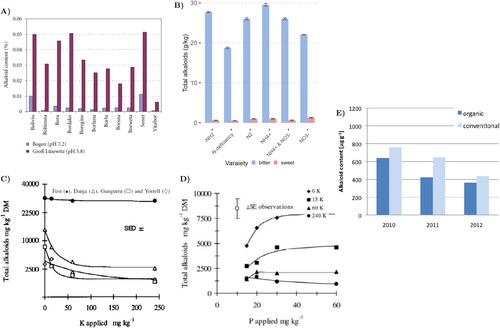Figures & data
Figure 1. (A) Production quantities of lupins by country (FAO Citation2020). (B) Production share of lupins by region (FAO Citation2020). (C) Top 10 lupins producers (mean values from 2000 to 2020) (FAO Citation2020). (D) Mean production and yield quantities of lupins in the World, from 1961 until 2020 (FAO Citation2020).
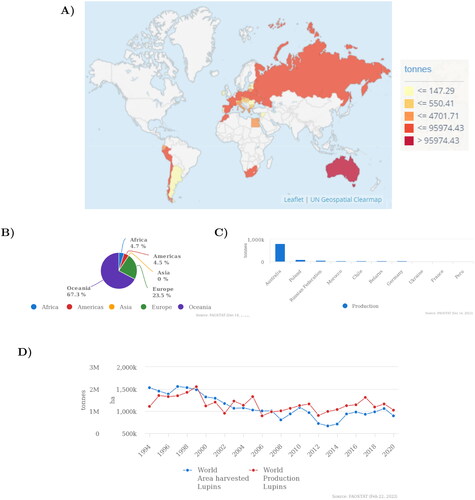
Figure 2. (A) Total number of studies and topics per year (from 1981 to 2022). (B) An overview of the studies reviewed. The numbers represent the number of studies, the total can be greater than 42 because one study can be focused on multiple species, use different crop locations, and investigate different topics.
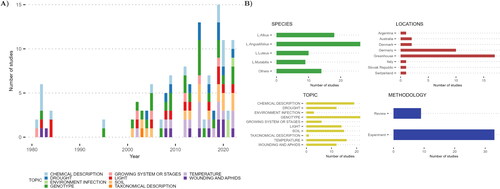
Figure 3. (A) Specific and total QAs mean content in different plant tissues of sweet and bitter lupins (Frick et al. Citation2018). (B) Mean alkaloid content of different six L. angustifolius genotypes (Jansen et al. Citation2009).
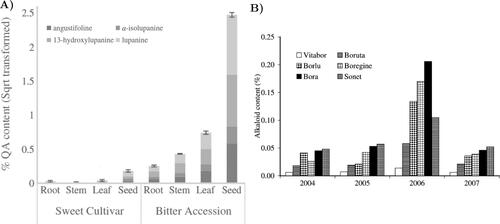
Figure 4. (A) Diurnal fluctuation in alkaloid contents of cell suspension cultures of L. polyphyllus (Wink and Witte Citation1984). (B) Grain QA (average) content in ‘Tanjil’ cultivar (L. angustifolius) under constant drought stress (Frick et al. Citation2018). (C) Relationship between the growing mean temperature and the alkaloid content of L. angustifolius according to several studies (Jansen et al. Citation2015, Citation2009).
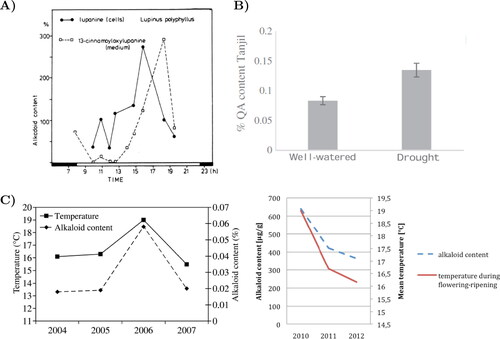
Figure 5. (A) Total alkaloid content in lupin seeds during germination (De Cortes Sánchez et al. Citation2005). (B) Patterns of accumulation of individual QAs in seeds and pods of bitter L. angustifolius throughout development as analyzed by LC- MS (Otterbach et al. Citation2019). (C) Wounding-induced alkaloid accumulation (mean) of L. polyphyllus (Wink Citation1983). (D) Aphis cytisorum resistance in relation to alkaloid content of Lupin plants (leaflets) (Wink et al. Citation1982).

Figure 6. (A) Influence of the soil pH on the main alkaloid content (annual mean) of different L. angustifolius cultivars (Jansen et al. Citation2012). (B) Effect of various nitrogen N-forms on total alkaloid content in seeds of ‘Butan’ (sweet) and ‘Bac’ (bitter) L. albus cultivars (mean and standard deviation). Data from (Ciesiolka et al. Citation2005). (C) Total QAs levels under K concentrations for a bitter variety (‘Fest’) and three sweet L. angustifolius varieties (Gremigni et al. Citation2001). (D) Total QAs levels under P and K concentrations for ‘Danja’, a sweet L. angustifolius variety (Gremigni et al. Citation2003). (E) Effect of the growing system on L. angustifolius cultivars (annual mean) (Jansen et al. Citation2015).
